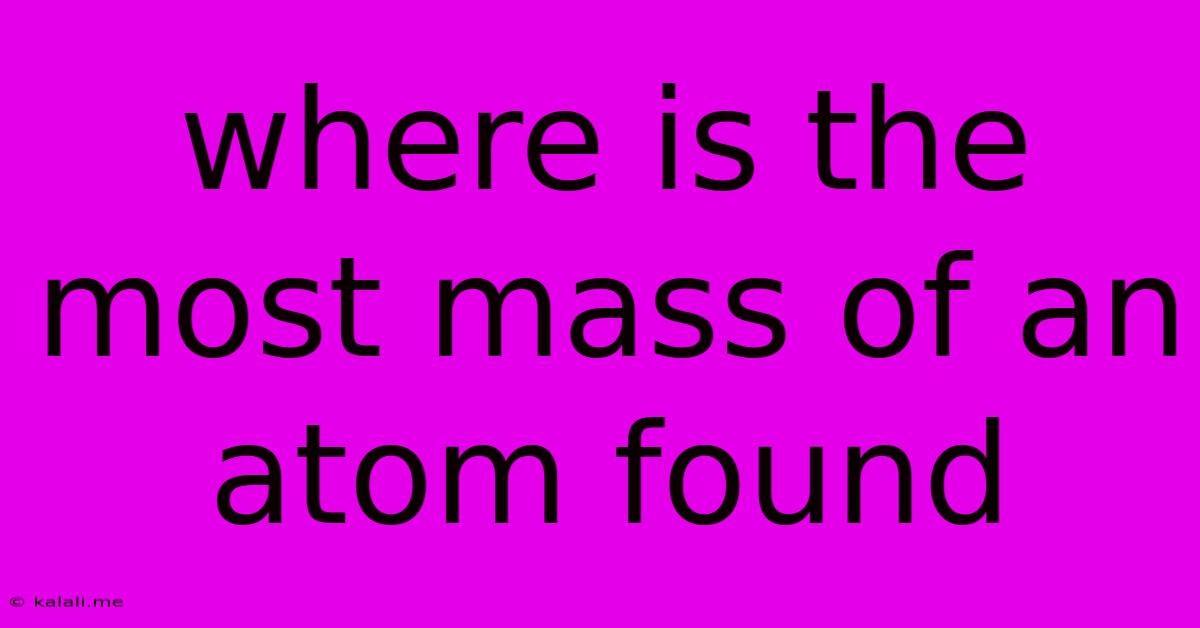Where Is The Most Mass Of An Atom Found
Kalali
Jun 13, 2025 · 2 min read

Table of Contents
Where is the Most Mass of an Atom Found? A Deep Dive into Atomic Structure
The vast majority of an atom's mass resides in its nucleus. This seemingly simple answer belies a fascinating complexity within the world of quantum physics. This article will explore the components of an atom and definitively answer the question, while providing a deeper understanding of atomic structure.
The atom is the fundamental building block of matter, composed primarily of three subatomic particles: protons, neutrons, and electrons. Understanding their relative masses and locations within the atom is key to understanding where the mass is concentrated.
Protons and Neutrons: The Heavyweight Champions
Protons and neutrons are found within the atom's nucleus, a tiny, dense region at the atom's center. Both particles possess approximately the same mass, significantly larger than that of an electron. A proton carries a positive electrical charge, while a neutron, as its name suggests, is electrically neutral. The combined mass of the protons and neutrons accounts for almost the entirety of an atom's mass.
Electrons: Lightweight Orbiters
Electrons, on the other hand, are much lighter than protons and neutrons. They are negatively charged and orbit the nucleus in regions called electron shells or orbitals. Their mass is so insignificant compared to the nucleus that it's often disregarded when calculating the overall mass of an atom.
Illustrative Example: The Hydrogen Atom
Let's consider the simplest atom, hydrogen. A hydrogen atom has one proton in its nucleus and one electron orbiting it. The mass of the electron is negligible compared to the proton. Therefore, almost all of the hydrogen atom's mass is concentrated within its single proton.
This concept holds true for all atoms, regardless of their complexity. While the number of protons, neutrons, and electrons varies between different elements, the principle remains consistent: the nucleus, containing protons and neutrons, holds the overwhelming majority of the atom's mass. The electrons, though crucial for chemical reactions and determining an atom's properties, contribute virtually nothing to its overall mass.
Beyond Mass: The Importance of Atomic Structure
Understanding where an atom's mass is located is crucial for comprehending various phenomena in chemistry and physics. This knowledge is fundamental to understanding:
- Nuclear reactions: Processes like nuclear fission and fusion involve changes in the nucleus, directly impacting the atom's mass.
- Isotopes: Atoms of the same element with different numbers of neutrons have different masses, impacting their stability and properties.
- Radioactive decay: Unstable isotopes undergo radioactive decay, emitting particles and changing their mass and composition.
In conclusion, the answer is clear: the nucleus, home to the protons and neutrons, contains almost all of an atom's mass. While electrons are vital components of the atom's structure and function, their mass is insignificant in comparison. This understanding forms a cornerstone of our comprehension of atomic structure and its implications across various scientific disciplines.
Latest Posts
Latest Posts
-
How Are Protists And Bacteria Different
Jun 14, 2025
-
The General Formula For The Alkane Series Is
Jun 14, 2025
-
A Fishbone Chart Is Also Known As A
Jun 14, 2025
-
First Laboratory Of Psychology Was Established By
Jun 14, 2025
-
Which Action Best Illustrates The Process Of Making An Interpretation
Jun 14, 2025
Related Post
Thank you for visiting our website which covers about Where Is The Most Mass Of An Atom Found . We hope the information provided has been useful to you. Feel free to contact us if you have any questions or need further assistance. See you next time and don't miss to bookmark.